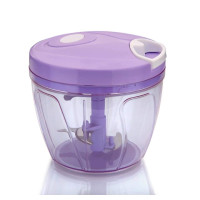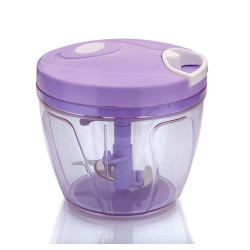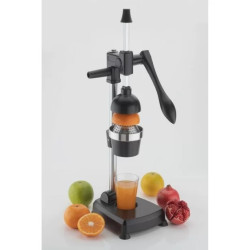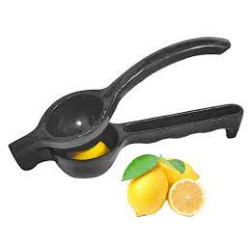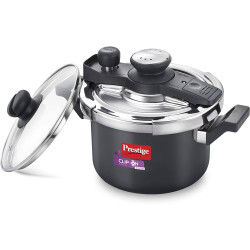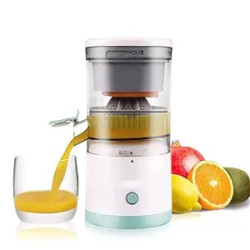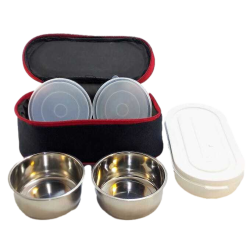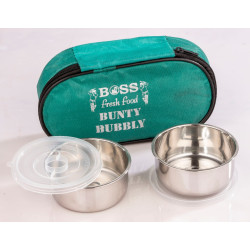-550x550w.jpg)
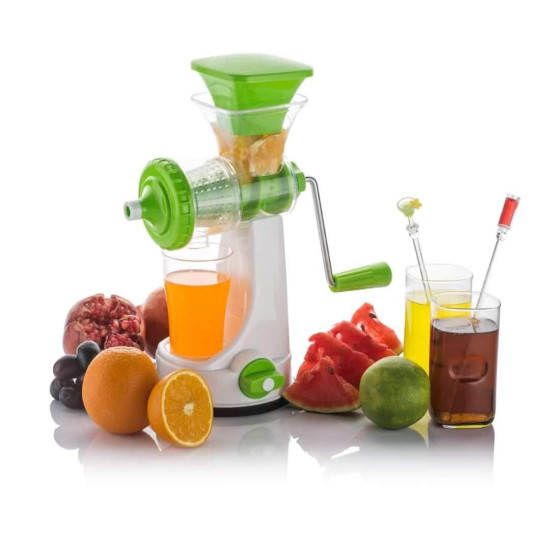
-80x80w.jpg)

More from this brand
Unlock the Freshness: Why a Plastic Juicer is Your Kitchen's Best Friend
In a world where health and wellness are paramount, the quest for fresh juice has never been more appealing. The plastic juicer - a kitchen companion that combines simplicity and efficiency. This handy tool unlocks the freshness that elevates your culinary creations. Lightweight, easy to clean, and remarkably durable, a plastic juicer offers an effortless way to incorporate vital nutrients into your diet. Imagine waking up to the sun shining through your kitchen window, the vibrant colors of fruits and vegetables waiting to be transformed into liquid gold. With just a few squeezes, you can enjoy the invigorating taste of freshly squeezed juice that enhances flavor while boosting your health. Discover why a plastic juicer is not just a gadget but a true friend to your kitchen, turning your daily routine into a delightful and nutritious experience.
The Benefits of Using a Plastic Juicer
Plastic juicers have a multitude of benefits that make them an essential tool in any kitchen. One of the most significant advantages is their lightweight nature. Unlike their metal counterparts, plastic juicers are easy to handle and maneuver, making the juicing process less cumbersome and more enjoyable. This is particularly beneficial for those who may have limited strength or dexterity, as the lightweight design reduces the physical effort required.
Additionally, plastic juicers are incredibly durable. Modern plastic materials are designed to withstand the rigors of daily use without cracking or breaking. This durability ensures that your plastic juicer can serve you faithfully for years, offering a reliable way to incorporate fresh juice into your diet. Moreover, because plastic is resistant to rust and corrosion, you don't have to worry about the longevity of your juicer when exposed to the acidic nature of citrus fruits.
Another significant benefit is the affordability of plastic juicers. Compared to metal or glass juicers, plastic models tend to be more budget-friendly without compromising on efficiency or performance. This makes them an excellent option for those who are just starting their health journey or for anyone looking for a cost-effective way to enhance their kitchen arsenal. With a plastic juicer, you get the best of both worlds: high performance and affordability.
Comparing Plastic Juicers to Other Materials
When it comes to choosing a juicer, the material of the juicer plays a crucial role in its performance and practicality. Plastic juicers stand out for their unique blend of advantages that often surpass those of other materials. For starters, glass juicers, while aesthetically pleasing, are prone to breakage. They are also generally heavier, making them less convenient for everyday use. Dropping a glass juicer could lead to an expensive and inconvenient replacement.
Metal juicers, on the other hand, are celebrated for their durability and strength. However, they come with their own set of drawbacks. Metals can react with the acids in fruits, leading to potential contamination and an altered taste of the juice. Additionally, metal juicers are often heavier and can be more challenging to clean, as they might require special care to avoid rusting. The heft of a metal juicer can also make it less appealing for quick, everyday use.
In comparison, plastic juicers offer a balanced solution. They are durable without being heavy, and they do not react with acidic juices, ensuring that the flavor of your juice remains pure and untainted. Furthermore, the maintenance of plastic juicers is straightforward and hassle-free, which is a significant advantage for those with busy lifestyles. The ease of use and maintenance makes plastic juicers an ideal choice for both beginners and experienced juicers alike.
Key Features to Look for in a Plastic Juicer
When selecting a plastic juicer, there are several key features to consider to ensure you choose a model that meets your needs and expectations. Firstly, look for a juicer with a sturdy construction. Although plastic is generally durable, the quality of the plastic can vary. Opt for BPA-free plastic to ensure that no harmful chemicals leach into your juice, especially when dealing with high-acid fruits.
Another essential feature is the design of the juice extractor. A well-designed extractor will maximize juice yield while minimizing pulp, seeds, and rind. Some plastic juicers come with multiple reamers or attachments to handle different sizes and types of fruits, which can be a versatile addition to your kitchen tools. Additionally, consider a model with a non-slip base to ensure stability during use, preventing accidents and spills.
Ease of cleaning is another critical factor. Juicers with detachable parts that are dishwasher safe can save you a significant amount of time and effort. Look for models with fewer nooks and crannies where pulp and juice can get trapped, as these can be difficult to clean thoroughly. Lastly, consider the capacity of the juicer. If you plan on making juice for multiple people or in larger quantities, a juicer with a larger reservoir will be more convenient.
How to Properly Use a Plastic Juicer
Using a plastic juicer is straightforward, but there are a few tips and techniques to maximize efficiency and get the best results. Begin by selecting fresh, ripe fruits as they tend to yield more juice and have a better flavor. Wash the fruits thoroughly to remove any dirt or pesticides that might be on the skin. For larger fruits like oranges and grapefruits, cut them in half to fit the juicer.
When you start juicing, apply consistent pressure to ensure all the juice is extracted. For manual plastic juicers, twist the fruit back and forth while pressing down to release the juice. Electric plastic juicers typically require less effort, as the machine does most of the work. Be sure to alternate between different fruits if you are making a mixed juice to combine flavors evenly.
After juicing, it’s essential to clean your juicer promptly. Leaving the pulp to dry can make cleaning more difficult. Rinse the parts under warm water and use a brush to remove any pulp residue. If your juicer is dishwasher safe, place the parts on the top rack to avoid damage from high heat. Proper cleaning and maintenance ensure your plastic juicer remains in good condition and ready for the next use.
Cleaning and Maintenance Tips for Longevity
Maintaining your plastic juicer is crucial for its longevity and performance. Regular cleaning after each use will prevent the buildup of pulp and juice residue, which can harbor bacteria and affect the taste of your juice. Begin by disassembling the juicer and rinsing each part under warm water. Use a soft brush to clean any crevices where pulp might get stuck.
For a more thorough cleaning, soak the parts in a solution of warm water and mild dish soap for about 10 minutes. This helps to break down any stubborn residue. Avoid using abrasive cleaners or scrubbers, as they can scratch the plastic and degrade its quality over time. If your juicer has any metal components, ensure they are dried thoroughly to prevent rusting.
To maintain the sharpness of the reamers and blades, clean them immediately after use. Dull blades can reduce the efficiency of your juicer, making the process more labor-intensive. Store your plastic juicer in a dry, cool place to avoid warping or damage from excessive heat. Regularly check for any cracks or signs of wear and tear, and replace parts as necessary to keep your juicer functioning optimally.
Popular Plastic Juicer Brands and Models
When it comes to choosing a plastic juicer, several brands stand out for their quality and performance. One notable brand is OXO, known for its ergonomic designs and durable construction. The OXO Good Grips Citrus Juicer is a popular model that features a comfortable non-slip grip and comes with two reamer sizes to handle different fruits. Its built-in measuring cup makes it easy to see how much juice you've extracted.
Another reputable brand is Chef'n, offering innovative and compact designs. The Chef'n FreshForce Citrus Juicer is a handheld model that uses a dual-gear mechanism to increase pressing power, making it easier to extract more juice with less effort. Its small size makes it convenient to store and ideal for quick juicing tasks.
For those looking for an electric option, the BLACK+DECKER CJ625 Citrus Juicer is a highly recommended model. It features an auto-reversing reamer to maximize juice extraction and adjustable pulp control to suit your preferences. The easy-to-read measurement markings and drip-free pour spout add to its user-friendly design.
Recipes to Try with Your Plastic Juicer
A plastic juicer opens up a world of culinary possibilities. Start your day with a refreshing glass of freshly squeezed orange juice. Simply halve your oranges and use the juicer to extract the juice. For a twist, add a splash of lemon or lime for an extra zesty kick. This vitamin C-packed drink will give you a vibrant start to your morning.
For a nutritious green juice, combine ingredients such as kale, spinach, cucumber, and green apples. Use your plastic juicer to extract the juice from each ingredient and mix them together. This drink is not only delicious but also loaded with essential vitamins and minerals that support overall health.
If you're in the mood for something more creative, try making a homemade salad dressing. Combine freshly squeezed lemon juice, olive oil, Dijon mustard, and a touch of honey. Whisk the ingredients together to create a tangy and flavorful dressing that pairs perfectly with a variety of salads. The freshness of the lemon juice will elevate the taste of your salad and make it more enjoyable.
Common Myths About Plastic Juicers
Despite their many benefits, plastic juicers are sometimes subject to misconceptions. One common myth is that plastic juicers are not durable. While it's true that lower-quality plastics can be prone to damage, high-quality plastic juicers are designed to withstand regular use without breaking or cracking. Brands that prioritize quality use durable, BPA-free plastics that ensure longevity.
Another myth is that plastic juicers retain odors and stains. While plastic can absorb strong odors and colors, this issue is easily mitigated with proper cleaning. Regular and thorough washing, along with occasional deep cleaning, can prevent odors and stains from setting in. Using lemon juice or baking soda during cleaning can also help to eliminate any persistent smells.
A third myth is that plastic juicers are not environmentally friendly. While it’s true that plastic production has environmental impacts, many plastic juicers are made from recyclable materials. Additionally, their lightweight nature means they require less energy to produce and transport compared to heavier materials like metal and glass. Choosing a durable, high-quality plastic juicer that lasts for years can be an eco-friendly choice in the long run.






